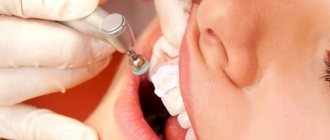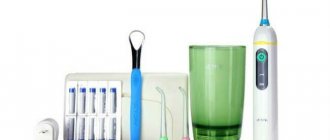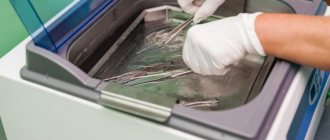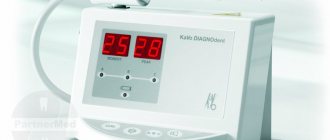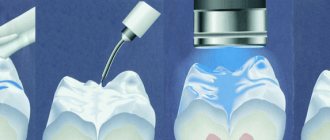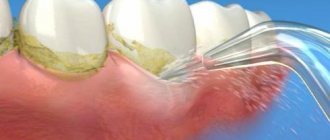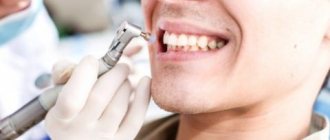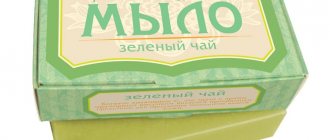Methods of professional oral hygiene
Professional hygiene includes 5 main methods of cleaning teeth from soft and hard deposits:
- mechanical;
- chemical;
- sandblasting;
- ultrasonic;
- laser
The first two procedures are performed manually, using only the dentist's skill and special instruments or chemical compounds. The last three methods are also called hardware methods due to the use of specialized instruments.
Mechanical cleaning: pros and cons
Professional oral hygiene mechanically involves manual removal of plaque and stone using dental instruments - forceps and scrapers.
Advantages of the mechanical method:
- low cost (only dental services are paid);
- suitable for allergy sufferers (there is simply nothing to cause a negative reaction);
- has no contraindications.
Disadvantages of using tongs and scrapers:
- duration of the procedure (the dentist and the patient get tired);
- injuries to the gums and enamel are possible (if the specialist’s qualifications leave much to be desired);
- Removing stone from under the gums is quite painful (anesthesia may be required).
Features of the chemical method
Professional hygiene of this type involves treating the entire surface of the teeth with special compounds. After some time (up to half an hour maximum), the chemical reagents come into contact with the deposits. The dentist can only remove waste and disinfect the oral cavity.
Advantages of manual teeth cleaning with gels and ointments:
- reasonable cost (15-20 percent more expensive than mechanical);
- quick procedure (40-45 minutes in total);
- cuts, scratches and other injuries are excluded.
Disadvantages of the chemical method:
- testing for allergic reactions is required;
- if the dentist is not experienced enough, chemical burns of the mucous membrane are possible;
- Cleaning is effective only on crowns; cervixes are poorly treated.
Why do we brush our teeth?
In the entire human body there is no more infected cavity than the oral cavity.
If you do not take proper care of it, then there is a threat not only of caries.
Infection and metabolic products of food debris provoke the development of diseases of internal organs, reduce the body's immunity, and produce foul breath.
Brushing your teeth is a voluntary action and, of course, is not punishable by criminal law.
But, if even in ancient times people attempted to read their teeth using chewed sticks and dry grass stems, then the benefits of this process have been known for a long time.
True, not all people did this, as in modern times.
In Southeast Asian countries, more than half of the rural population has no idea about a toothbrush.
The result is tooth loss.
Toothless people never stood at the highest levels of society and did not serve as objects to be emulated.
Specifics of sandblasting
The method uses a special Air Flow apparatus. A mixture of air, flavored water and small round particles of soda is supplied from the cleaning head under high pressure.
Strengths of professional oral hygiene using a sandblasting machine:
- saving time (about 30 minutes);
- reasonable price (twice as high as mechanical cleaning);
- soft plaque is easily removed;
- pleasant taste of mint or lemon;
- The entire procedure is comfortable and painless.
Weaknesses of using Air Flow technology:
- will not help if the stones are large or old;
- increases sensitivity for a couple of days;
- scratches the enamel a little, so additional polishing is needed;
- Contraindicated for pregnant women, children, asthmatics, as well as for HIV, AIDS and hepatitis C;
- reduces the service life of composite fillings and ceramic dentures.
How often do you need to have your teeth cleaned by the dentist?
As a rule, subject to good home hygiene, professional cleaning is recommended for adults at least once every 6 months.
For those who smoke, drink a lot of coffee or are not very active in caring for their teeth at home - at least once every 3 months.
If you are undergoing orthodontic treatment - once every 3 months.
If you have inflammatory diseases of periodontal tissues, then after basic treatment by a periodontist, you need to carry out special (maintenance) hygiene once every 3 months. It additionally includes air-abrasive polishing of the root surface.
Advantages and disadvantages of ultrasound technique
The method involves the use of a special device - a scaler. Ultrasonic waves are transmitted through the tool head, remotely splitting deposits and simultaneously washing them away with water pressure.
What are the benefits of professional hygiene using a scaler:
- effectively removes stones under the gums and on enamel;
- there is no direct contact of the device with the teeth (relevant for increased gag reflex);
- The procedure is quick (35-40 minutes);
- there are no painful or other unpleasant sensations.
What's bad about ultrasonic cleaning:
- the price is “biting” (one and a half times higher than the cost of Air Flow);
- Contraindicated for those wearing pacemakers, pregnant women and minors;
- undesirable if you are prone to respiratory diseases.
Characteristics of laser cleaning
Professional oral hygiene is achieved due to the fact that plaque and tartar contain much more water than enamel. A laser beam remotely dries teeth. This is completely harmless for the enamel and gums, but plaque and stones crack and fall off spontaneously.
Advantages of using laser technology:
- high efficiency with absolutely silent operation of the device;
- comfortable processing, no direct contact;
- brightens enamel to a natural shade;
- the result lasts longer than after other methods.
Disadvantages of laser cleaning:
- very high cost (the equipment is expensive and not available in all clinics);
- a huge number of contraindications: diseases of the respiratory, circulatory, cardiovascular systems, infections, pregnancy and much more;
- Braces cannot be used during bite correction.
What not to do before the procedure
To prepare for the procedure, you must follow the rules determined by the doctor in accordance with the characteristics of the body and the course of the disease.
If the prescribed recommendations are violated before the ultrasound, the patient must inform the specialist about them.
In addition, the doctor should be aware of the use of antispasmodic medications.
Immediately before the examination procedure, doctors prohibit certain actions. In order for the examination to be successful, the patient is informed what cannot be done before an abdominal ultrasound.
List of abstinences (what not to do):
- eat and drink in the next 10 hours before the ultrasound, unless this is necessary to obtain reliable diagnostic results;
- use prohibited foods that can lead to flatulence;
- 2 hours before the scheduled examination, you should not smoke, eat candy or chew gum (this can cause spasm of the walls of the stomach and gallbladder, leading to the swallowing of excess air);
- Do not drink alcohol for 2-3 days;
- after an X-ray with contrast liquid, at least 2 days must pass; this rule also applies to fibrogastroduodenoscopy and conoscopy;
During abdominal ultrasound for young children, the duration of abstinence from eating is different. So, children under one year old do not receive food for 3 hours, usually for this you can skip one meal, from 1 year to 4 years - 4 hours and up to 14 years - 6 hours.
Liquids should not be consumed within 1 hour.
During lactation, medications should be taken with caution. Cystitis during breastfeeding can be treated with safe remedies.
Read about the causes of kidney disease during pregnancy here.
Kidney colds can be dangerous, and unfortunately, most patients come to the doctor with an advanced stage of the disease. Read more about what to do if your kidneys are cold in this article.
Which method of professional oral hygiene is better?
There is no ideal dental cleaning technique. The task of a good specialist is to combine those methods that best suit a particular patient.
As a rule, in the absence of special contraindications, comprehensive professional hygiene is carried out in several stages:
- the dentist invites the patient to brush his teeth with a regular brush;
- the largest stones are removed manually using tongs and scrapers;
- the remaining solid deposits are broken down by ultrasound or laser;
- the entire oral cavity is superficially treated with a sandblasting device;
- the patient thoroughly rinses his mouth with special solutions;
- the dentist checks the effectiveness of cleaning and makes adjustments if necessary;
- the vestibular surface of each tooth is carefully polished and coated with a special fluorine-containing varnish;
- the specialist gives recommendations on further home care (including which brush and toothpaste is best to buy for a particular patient).
The first few days after comprehensive cleaning, enamel is especially sensitive and susceptible to staining. Experts recommend not smoking, not using whitening paste, and not using any artificial or natural dyes for at least two days.
To keep your teeth healthy and attractive, it is advisable to carry out professional oral hygiene every six months.
Basic nutrition rules
It is necessary to limit your diet three days before the appointed date. The period during which eating and drinking is completely excluded varies depending on the age of the patient.
Prohibited Products
Foods that promote flatulence should be excluded from the menu.
- Fresh milk - it contains lactose, the breakdown of which in the adult body occurs slowly due to the lack of special enzymes. Accumulating, it contributes to bloating.
- Fresh and canned fruits - the plant fiber they contain causes flatulence.
- Confectionery products, rich pastries and rye bread - they contain polysaccharides that enhance fermentation in the digestive tract.
- Plants of the legume family - peas, beans, lentils. In addition to polysaccharides, they contain vegetable protein, which is difficult to digest by the body.
- Some vegetables and greens - potatoes, cabbage, onions, garlic, asparagus.
- Corn, both boiled and canned.
- Hot and spicy seasonings - irritating the walls of the stomach and intestines, they can cause spasms.
- Fried and salty foods that excite thirst.
- Fatty varieties of fish and meat - excess fat slows down the process of digestion and absorption of food.
- Any carbonated drinks.
- Strong tea and coffee.
Drinking alcohol, even in small quantities, is out of the question. The prohibition also applies to chewing gum - chewing it leads to the ingress of air, which accumulates in the intestines.
Authorized Products
Foods that are allowed to be consumed on the eve of an ultrasound include:
- Cereal porridges and soups cooked in water. Millet is excluded, since this grain is difficult to digest.
- Boiled lean meat - chicken, turkey, rabbit, veal.
- Lean fish - pike perch, hake, navaga, pollock, blue whiting - boiled or steamed.
- Soft-boiled chicken egg - no more than one per day.
- Low-fat cottage cheese or kefir - without dyes, sweeteners and other additives.
- Stale white bread, crackers, lightly dried in the oven or toaster, dry unsweetened cookies.
You need to eat often, every 2-3 hours, slowly, chewing your food thoroughly. Portions should be small - no more than 250 g at a time. You should drink weakly brewed green tea without sugar or plain water without gases. The daily intake of fluid should not exceed one and a half liters.
The method of diagnosing pathologies of internal organs using ultrasound is permitted for pregnant women. The dietary nutrition of pregnant and nursing mothers on the eve of an ultrasound is no different from the above list of products, however, portions can be increased to 300 g. You can also drink more - up to 2-2.5 liters per day.
It is necessary to check with your pediatrician about what changes should be made to the diet and nature of the diet of an infant, as well as children under three years of age.
During the preparatory period, to improve digestive functions, the doctor may recommend that the patient take a popular and inexpensive adsorbent - activated carbon. It is also possible to take more modern pharmacological drugs with adsorbent properties - Smecta or Espumisan. They will speed up the removal of toxins from the body and reduce the manifestations of flatulence, eliminating belching and bloating. If intestinal motility is weak and the patient is prone to constipation, on the eve of the examination day, you can take a mild laxative or administer a Microvax or Norgalask microenema.
How to eat
How many hours before an abdominal ultrasound an adult or child should not eat or drink is determined by the doctor, but there are general recommendations. For adult patients and children over twelve years of age, the last meal should occur no later than 12 hours before the procedure. As a rule, ultrasound of internal organs is performed in the morning, so snacks after dinner are excluded. If the procedure is scheduled for the evening, allow a light breakfast before 10 am. For pregnant or nursing mothers, the examination is always scheduled for the morning in order to reduce the restrictive period to a minimum.
You can drink small amounts of water (half a glass) no later than 6-8 hours before the procedure, if we are talking about examining the gastrointestinal tract. If the kidneys and bladder are to be checked, the requirements are opposite - you need to drink from three to six glasses of water in an hour so that the kidneys work intensively at the time of the examination, and the bladder is full, and the ultrasound can show a clear picture of the condition of the urinary organs in the process of their functioning. You should also drink water before an ovarian ultrasound. These paired female organs, located deep in the pelvis, are very small - about the size of a plum. During a normal procedure, they cannot be detected. A full bladder presses on the ovary, raising it closer to the surface and making it more visible on the monitor screen, making it easier to make a diagnosis.
Children who are not yet 12 months old, on the eve of an abdominal ultrasound, skip one feeding - the one closest to the procedure. Children from one to three years old should not eat 4 hours before the test. A child over 5 years old must endure a more strict diet: he will have to not eat or drink for 6 hours.
The diagnostic technique of ultrasound for examining the internal organs of the abdominal cavity has proven itself to be the best. Its main positive qualities are high accuracy combined with harmlessness, painlessness and speed of passage. Preparation for the procedure is so simple that both adults and children can easily endure it.
